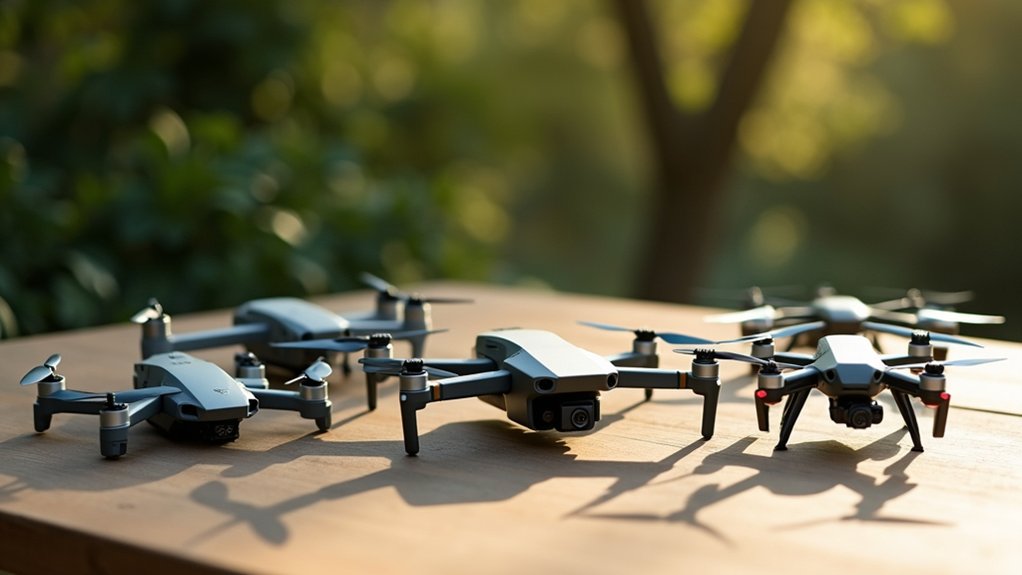What is a drone? Tips to understand different types
If you’re eager to dive into the fascinating world of drones, it’s crucial to understand what differentiates each type. From casual hobbyists to commercial operators, every drone offers distinct advantages. When selecting a drone, it’s not just about price or appearance, it’s about aligning the technology with your specific needs. Before making your choice, consider the key differences that could significantly influence your experience and outcomes with drones. By understanding these nuances, you’ll be better equipped to select the perfect drone for your adventures in technology.

Recognizing consumer vs. commercial drones
When you dive into the world of drones, you’ll come across two primary types: consumer drones and commercial drones.
Consumer drones, perfect for hobbies or casual photography, are user-friendly and come at a lower price point, making them ideal for tech enthusiasts.
On the other hand, commercial drones are designed for businesses and professionals. These drones boast advanced features, greater durability, and specialized functions for tasks like mapping, inspections, or delivery. This justifies their higher cost and complexity.
Whether you’re interested in consumer drones or commercial drones, each category offers unique benefits tailored to different needs.
Identifying fixed-wing and rotary-wing models
When diving into the world of drones, you’ll quickly encounter two popular designs: fixed-wing drones and rotary-wing drones.
Fixed-wing drones, resembling airplanes, use wings to generate lift, enabling longer flight times and greater range. On the other hand, rotary-wing drones, like quadcopters, rely on spinning rotors for lift, which allows them to hover and perform vertical take-offs and landings.
Understanding the differences between fixed-wing drones and rotary-wing drones can help you identify their unique strengths and determine the ideal scenarios for their use.
Whether you’re into technology, apps, or the latest in smartphone and software advancements, knowing about fixed-wing drones and rotary-wing drones will keep you informed and ahead of the curve.
Exploring hybrid and specialty drone designs
In the rapidly evolving world of drone technology, you’ll encounter innovative hybrid and specialty drone designs that transcend traditional fixed-wing and rotary-wing models.
Hybrid drones, often featuring vertical takeoff capabilities combined with efficient forward flight, provide enhanced flexibility for various applications.
Meanwhile, specialty drones, such as underwater drones, tethered drones, and foldable drones, are crafted to tackle unique challenges.
Exploring these hybrid and specialty drone designs allows you to align a drone’s capabilities with your specific needs, whether you’re involved in mapping, surveillance, or creative projects.
As technology advances, the potential applications for hybrid and specialty drones continue to expand, making them essential tools in the ever-changing landscape of technology, apps, smartphones, and software.
Assessing drone capabilities and payloads
When it comes to understanding a drone’s capabilities and payload options, it’s crucial to make informed choices for your tech tasks.
Whether you’re into technology, apps, smartphones, or software, knowing what a drone can do is vital. Consider the drone’s flight time, range, speed, and stability—these are key factors for any tech enthusiast.
Think about the payload capacity as well. Can this drone carry cameras, sensors, or delivery packages that align with your tech needs?
Look for features like gimbal stabilization, modular attachments, and weather resistance to ensure your drone meets your tech requirements.
Understanding regulations for various drone types
Before you launch your drone, it’s crucial to understand the specific rules for your drone type and purpose.
Different drone types—whether recreational, commercial, or specialized—are subject to different regulations. Always check with your country’s aviation authority regarding drone registration, flight restrictions, and certification requirements.
Remember, not all drones are treated equally; models that are heavier, equipped with cameras, or feature advanced technology may have stricter rules.
Stay informed, keep your drone knowledge current, and always fly responsibly.
Conclusion
By understanding the different types of drones, you’ll make smarter choices and fly with more confidence. It’s essential to compare consumer drones and commercial drones, as these categories serve different purposes.
Also, learn to distinguish fixed-wing drones from rotary-wing drones, as well as explore hybrids and specialty drone designs. Always assess the payload capabilities of drones to ensure they align with your needs. Additionally, staying updated with drone regulations is crucial to flying safely and legally. With these tips on the types of drones, you’re set to enjoy a fulfilling and safe journey in the world of drone technology.